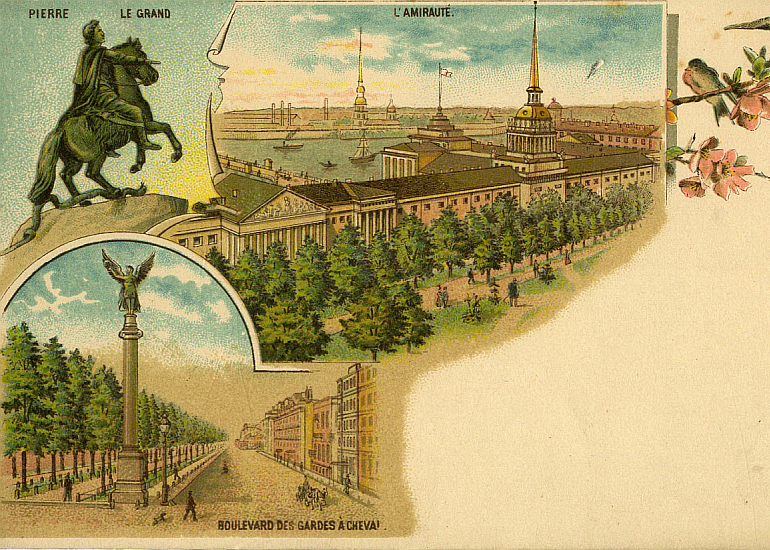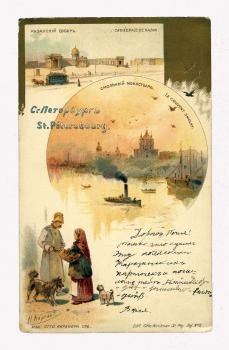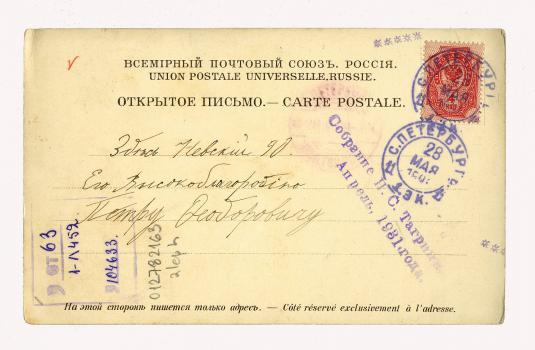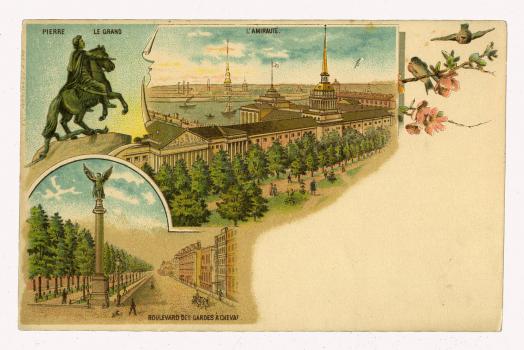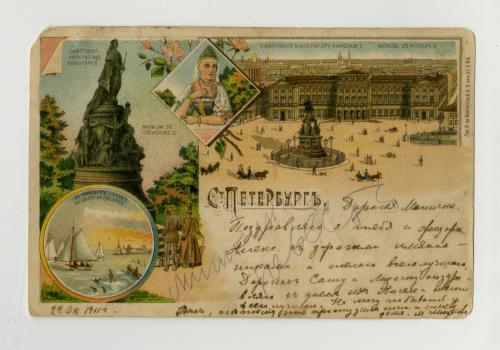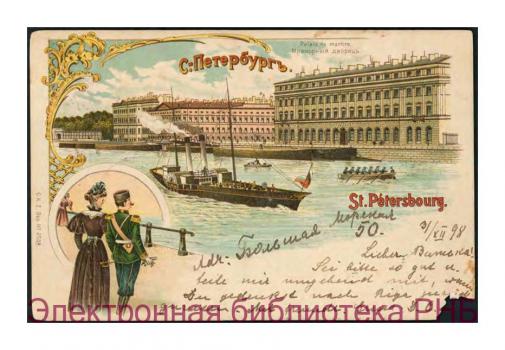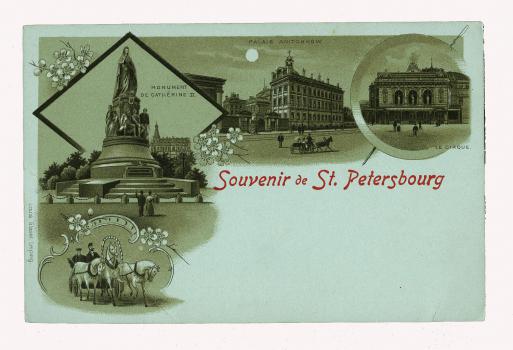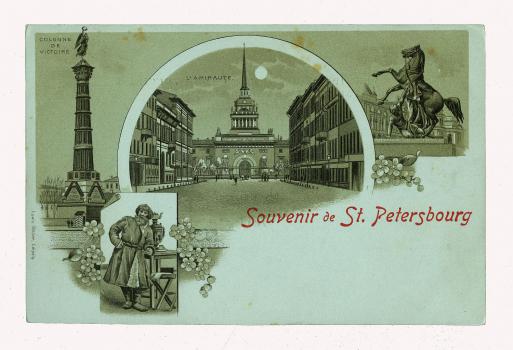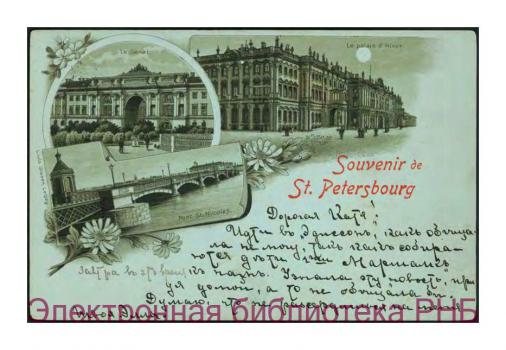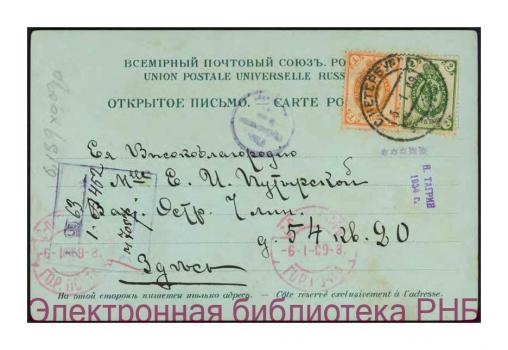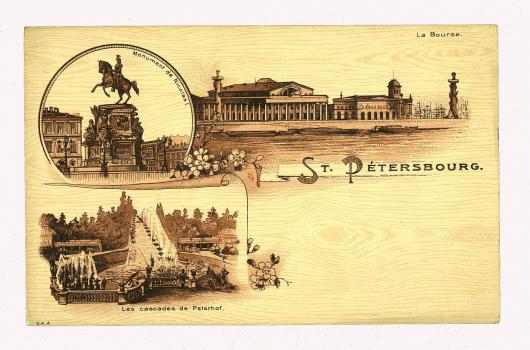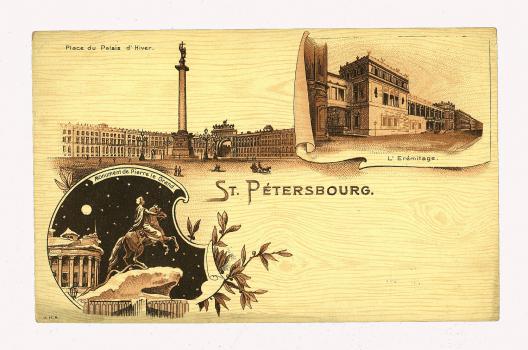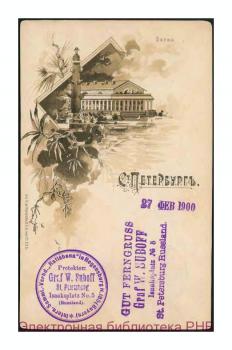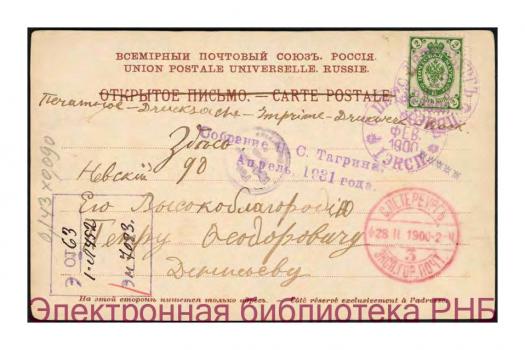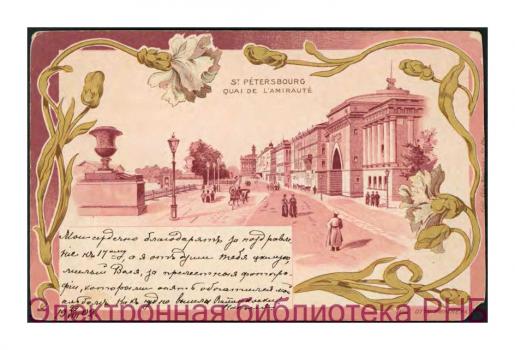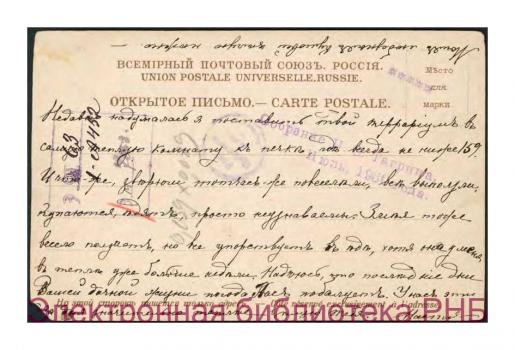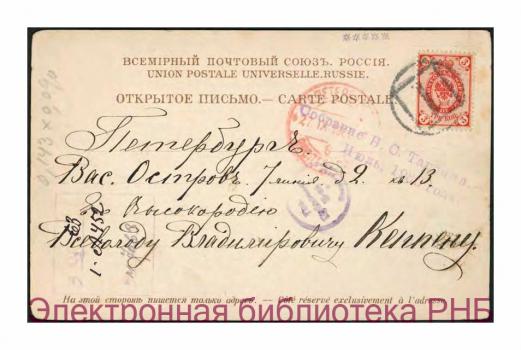Souvenir Postcards of St. Petersburg
1898‑1900
In 1898, ten postcards were published by St. Petersburg merchant Otto Kirchner (1848‑1901), а national of the German Duchy of Anhalt who owned a store and a factory of office books, as well as a bookbinding workshop, Kirchner was a member of the Russian Society of Booksellers and Publishers. Kirchner in 1871 opened a bookbinding workshop in St. Petersburg, at number 14 on Malaya Morskaya Street, and in 1879, for the first time, he also started publishing calendars. The business grew and developed, and in 1894-1895, a complex of new buildings was built to expand production on the Petersburg side (Bolshaya Pushkarskaya street, house number 10). The three-storey factory employed more than 250 workers and 120 machines, various departments provided all stages of the book binding process. Calendars, notebooks, photocopy and office books were also made here. At the beginning of the 20th century, after the death of Kirchner, the enterprise passed to his sons, and after nationalization in 1918, it became known as the Svetoch State Factory of Office Books.
Kirchner's postcards are the only souvenir postcards of St. Petersburg where the author of the originals is known - he was the artist and writer Nikolai Karazin (1842‑1908). A graduate of the 2nd Moscow Cadet Corps, he was in military service for almost ten years and at the same time attended the Imperial Academy of Arts as a volunteer, and then studied in Paris. Since the 1870s he gained fame as a draftsman, working for domestic and foreign magazines. Karazin also illustrated books, including novels, novels, and short stories written by him. From the end of the 19th century, his interests included a new type of applied graphics, the postcard.
For this series, Karazin created compositions made up of the city views and genre scenes. A postcard from collections of the National Library of Russia, depicting a statue of Emperor Nicholas, was not sent by mail; in place for a message it has an ink stamp: “V. Felshov” (it is possible that this is the name of the collector). Another postcard, with views of the Kazan Cathedral and the Smolny Monastery, was sent within the capital; the year is not clearly visible on the postmarks, but it is probably 1898. It addresses to one of the first postcards collectors in St. Petersburg. “Dear Petya! I have just bought this set of Karazin's cards and am sending it to you,” reads the message to “His Honorable Petr Feodorovich”.
The recipient of this postcard was Pyotr Denisyev (1865 or 1866 - not earlier than 1936), a hereditary nobleman, a son of Fyodor Denisyev (1825-1875) and Nadezhda Petrovna, nee Princess Kozlovskaya (1844-1891). From 1885 he served for various institutions in St. Petersburg. In 1898, the collegiate assessor Denisiev, who lived at number 90 on Nevsky Prospect, was a senior clerk in the office of the council of the State Noble Land Bank. From the All Petersburg Address Book for 1901, it is known that he was also the Consumer Society Board Chairman at the State Nobles' Land Bank, its special department and the Peasant Land Bank. While participating in charity work, Denisiev was a member of the mug and donation commission in the Department for the Protection of Children from Cruelty at the Society for the Care of Poor and Sick children ("Blue Cross"). Denisyev also had a sports passion - he was a member of the Society of Speed Ice Skating Fans on the Ponds of Yusupov Garden. Moreover, from the second half of the 1890s, he started collecting postcards. Like many at that time, he added to the collection only those postcards that showed views of an area from where they were sent.
By 1917, Denisiev had the rank of state councilor. In Soviet times, he continued to work in Petrograd-Leningrad, and in 1929 he retired and worked in a disabled artel. In the spring of 1931, almost 14,000 postcards from his collection were bought by N.S. Tagrin from a second-hand book dealer. Tagrin later recalled: “In a dark, dusty closet, in the smoky lamplight, a large “grandfather’s” chest opens, all filled to the brim with postcards”. After this acquisition, the above mentioned Tagrin collection grew to 65,000 items.
In March 1935, probably during the eviction of “former noblemen” from Leningrad, Petr Denisiev, who was then about 70 years old, and his wife were deported for 5 years from Leningrad to Ufa, where they stayed in June 1936.
In 1898, another series of six postcards appeared in St. Petersburg: it was printed by Carl De-Castelli's Lithography. De-Castelli (Castelli) was active in St. Petersburg from the 1870s. As an engraver, he is most known for creating tables with medals for the three-volume edition of Medals in Honor of Russian Government Officials and Private Individuals (1880-1896) by Julius Gottlieb Iversen. Small portraits, engraved at the same time, constitute a separate album Lovers of Russian Antiquities(1880). I.I. Tolstoy's research Ancient Russian Coins of the Grand Principality of Kiev(1882) was issued with a lithographed cover and eleven engraved tables made by De-Castelli.
D.A. Rovinsky in his Detailed Dictionary of Russian Engravers pointed out that De-Castelli " owns the only printing press in St. Petersburg at the present time". It is about the period between 1880 and 1895 and, probably, about prints from metal molds. In the list of printing houses compiled on January 1, 1894 and published in the Government Gazette, the establishment of the Bavarian citizen De-Castelli appears in two sections: "Lithography" "Metallurgy". But if there were more than thirty lithographys in the capital, then there were only four metallographys.
At that time De-Castelli's Lithography operated in the house no. 22 on the 11th line of Vasilyevsky Island. A few years later - by 1900 - his establishment moved to the house no. 37 on the 6th line. It can be assumed that around 1909 he retired. Leonid Jung became the owner of De-Castelli's Lithography and it moved to Mikhailovskaya Street in Volkova Village (now Salov Street). De-Castelli himself also left Vasilyevsky Island - especially because a new apartment building began constructed in 1909 on site no. 37 along the 6th line. He lived first in house no. 2, Spassky Lane, and then in house no. 349 on Udelny Prospekt. The last time the name of De-Castelli comes up in the All Petersburg Address Book in 1910.
The 1898 series was reprinted several times in De-Castelli's Lithography, with slight differences in design. One of the two postcards kept in the National Library of Russia, featuring statues of Catherine II, Nicholas I and a view of the Gulf of Finland, was printed in a workshop on the 6th line of Vasilyevsky Island, that is, probably already around 1900. Although the card came in the mail, in this case, postmarks do not help to date it: the postcard was used for sending congratulations on October 22, 1911, years after it was made.
In 1898, European publishers also paid attention to the theme of St. Petersburg – for example, fifteen postcards were published in Switzerland. They were produced by Сarl Künzli (1862‑1925) from Zurich. Initial letters of his name, surname and the city name formed the abbreviation "C. K. Z.» (Carl Künzli, Zürich) featured on these postcards. Künzli arrived in Zurich in 1889. and initially ran a stationery shop. Soon he began to publish view postcards, which were printed for him in Germany, in Dresden. In 1896, Künzli registered his own art publishing house (his firm was also a wholesaler of top quality paper), but in 1899 shut down his own business. Until 1903, he was the director of the Künzli Postcard Publishing Company, organized by the brothers Anton and Josef Künzli (Carl was their nephew), then was the manager and later owner of Künzli-Tobler Company. After Künzli's death, the publishing house passed to his son, and then – to the grandson, and lasted until the second half of the 20th century.
The National Library of Russia has the only postcard from the series, depicting the Marble Palace. Interestingly that the card was delivered from the sender to the addressee for New Year's Eve: on December 31, 1898, it was stamped at the post office in St. Petersburg, and on January 1, 1899 – in Narva.
In 1898, the already mentioned Louis Glaser repeated his last year's series of ten postcards, in tonal version, imitating the night scenes of St. Petersburg. In a similar design, he published views of other European places – for example, the German city Triberg im Schwarzwald and the Danish capital Copenhagen.
One of the three postcards of the series stored in the National Library of Russia, on January 6, 1909, was received by mail by Mademoiselle Ekaterina Putyrskaya (probably a daughter of the hereditary honorary citizen Ivan Putyrsky), who lived in house No. 54 on the 7th line of Vasilyevsky Island. “I can’t go to Edison as promised [,],” Ekaterina was warned by her friend. Probably, one of the capital's "cinema" was meant: either "Edisson"; on Malaya Konyushennaya Street, or located much closer to the house of the Putyrsky "Edisson Fars" in the house no. 14 on the 19th line of the Vasilyevsky Island.
In 1900, the Swedish Granberg Joint Stock Company launched a new series. The series had a monochromatic color scheme when a single base color formed the foundation of the postcards' color design, as if imitating wood burning. It is unusual that one of the four postcards of the series features a view of a suburban imperial residence – Peterhof with its Grand Cascade.
A new series was printed in 1900 in the lithographic workshop of Carl De-Castelli, which had already moved to house no. 37 on the 6th line of Vasilyevsky Island. Each of the six almost monochrome postcards shows only one view adorned with ornamental and floral decorations.
(галерея-MA51944)
A copy of the postcard titled St. Petersburg. The Stock Exchange, contained in the collection of the National Library of Russia, deserves special mention, since it is associated with four names: V.P. Zubov, P.F. Denisiev, N.S. Tagrin, I.N. Churakov. Bellow the image on the postcard are ink stamps: «Intern. Samml.‑Verbd. “Ratisbona” in Regensburg H. 185 (Bayern). Protektor: Graf W. Suboff St. Petersburg Isaaksplatz № 5 (Russland)», «Gut Ferngruss Graf W. Suboff Isaaksplatz № 5 St. Petersburg Russland»; there is also another stamp bearing the date: "February 27, 1900". Count Valentin Zubov (1884‑1969) mentioned here was at that moment fifteen-odd years old, he was listed as a student of the Second St. Petersburg Gymnasium in Kazanskaya Street, but studied at home. Twelve years later, he will open the first scientific art history institution in our country, the current Russian Institute of Art History, on the lower floor of the family house, the address of which can be seen on postmarks: house no. 5, St. Isaac's Square. By a strange coincidence, this is the educational institution where N.S. Tagrin studied, to whose collection the postcard was transferred in 1931 from the collection of P. Denisyev, its recipient (both have been mentioned before).
Obviously, Tagrin exchanged postcards with other collectors. This explains the fact that some copies with his owner's stamps are now part of the collection of the engineer-economist Igor Churakov (1892‑1942), which also kept at the National LIbrary of Russia. Churakov began collecting postcards as early as 1904. In the 1930, he was a member of the philocartist section of the Leningrad Society of Collectors, like Tagrin. Churakov died in besieged Leningrad, and his collection of topographic postcards, numbering over 50,000 items, was acquired by the State Public Library (now the National Library of Russia) in 1942.
A new series of ten cards was issued by another St. Petersburg publisher – the already mentioned Otto Kirchner. These postcards were reprinted several times in different color shades. Noteworthy are the copies of two postcards, held in the National Library of Russia, which have handwritten messages dating back to 1902. One of them, depicting the Admiralty Quay, was likely sent in an envelope: the message was written not only in the place intended for it, but also in the space for the address. On August 22, the sender, signed "Nastya", thanked the boy Volya, who lived then at the summer house, for photos he sent and told how the inhabitants of his terrarium and the snake revived after being transferred to a warm room.
On September 26, the same Nastya sent a happy birthday greeting to Volya. The second postcard was mailed. This helped to set the addressee of both messages – fifteen-year-old Vsevolod Köppen (1887 - after 1967), who lived on the 7th line of Vasilyevsky Island.
At the time of receiving the postcards in 1902, Köppen was studying at the Imperial School of Law, to which he was transferred in 1898. Interestingly, these are not the only fragments of his family correspondence that came into the collection of N. Tagrin by July 1930, and from it to the collection of I. Churakov. On October 6, 1901, Vsevolod sent a postcard titled St. Petersburg. Imperial School of Law to inform his mother, Nadezhda Köppen (née Tyrtova), that he was in the holpital.
After graduating from the School of Law in 1908, Köppen joined the Finnish Life Guards Regiment as a second lieutenant. Subsequently, he rose to the rank of captain, was awarded the Order of St. Stanislaus, 3rd degree. During the First World War he was wounded and then shell-shocked. During the Civil War, Köppen served in the anti-communist White Army in the 8th Infantry Regiment of the Semenov North-Western Army, but then - no later than 1923 - he returned to Soviet Russia.
After 1900, the production of lithographed souvenir postcards ended. City views, made by a draftsman, were replaced by photographic images. However, the 1890s sowed the seeds for flourishing of Russian artistic postcards. The rare postcards presented at the exhibition confirm the statement by Natalya Shabelskaya expressed in 1899, "Not so long ago, our postcards were produced abroad, recently they have already begun to be printed in Russia and designed by our the best artists. We hope that other artists follow their example, and our postcards become as artistic, elegant, instructive and useful in various respects as Western European ones, that this new branch of the art industry develop and flourish more and more - for the benefit and glory our fatherland."
